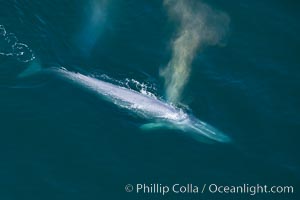
Blue whale, exhaling as it surfaces from a dive, aerial photo. The blue whale is the largest animal ever to have lived on Earth, exceeding 100' in length and 200 tons in weight.
Species: Blue whale, Balaenoptera musculus
Location: Redondo Beach, California
Image ID: 25954
Species: Blue whale, Balaenoptera musculus
Location: Redondo Beach, California
Image ID: 25954
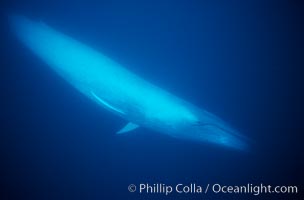
Blue whale, the largest animal ever to live on earth, underwater view in the open ocean.
Species: Blue whale, Balaenoptera musculus
Image ID: 05810
Species: Blue whale, Balaenoptera musculus
Image ID: 05810
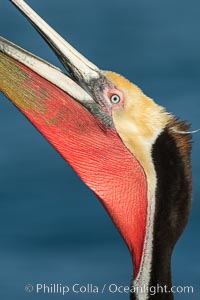
California Brown Pelican head throw, stretching its throat to keep it flexible and healthy. Note the winter mating plumage, olive and red throat, yellow head.
Species: Brown Pelican, Pelecanus occidentalis, Pelecanus occidentalis californicus
Location: La Jolla, California
Image ID: 30413
Species: Brown Pelican, Pelecanus occidentalis, Pelecanus occidentalis californicus
Location: La Jolla, California
Image ID: 30413
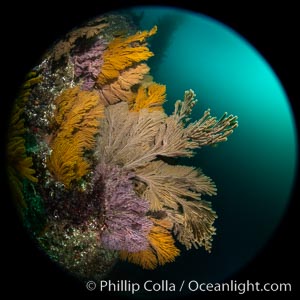
Brown gorgonian and California golden gorgonian on underwater rocky reef below kelp forest, Catalina Island. Gorgonians are filter-feeding temperate colonial species that lives on the rocky bottom at depths between 50 to 200 feet deep. Each individual polyp is a distinct animal, together they secrete calcium that forms the structure of the colony. Gorgonians are oriented at right angles to prevailing water currents to capture plankton drifting by.
Species: Brown gorgonian, California golden gorgonian, Muricea californica, Muricea fruticosa
Location: Catalina Island, California
Image ID: 37292
Species: Brown gorgonian, California golden gorgonian, Muricea californica, Muricea fruticosa
Location: Catalina Island, California
Image ID: 37292
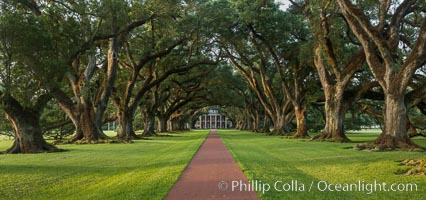
Oak Alley Plantation and its famous shaded tunnel of 300-year-old southern live oak trees (Quercus virginiana). The plantation is now designated as a National Historic Landmark.
Species: Southern live oak, Quercus virginiana
Location: Oak Alley Plantation, Vacherie, Louisiana
Image ID: 31015
Panorama dimensions: 6786 x 14447
Species: Southern live oak, Quercus virginiana
Location: Oak Alley Plantation, Vacherie, Louisiana
Image ID: 31015
Panorama dimensions: 6786 x 14447
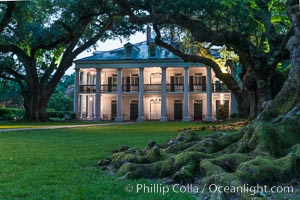
Oak Alley Plantation and its famous shaded tunnel of 300-year-old southern live oak trees (Quercus virginiana). The plantation is now designated as a National Historic Landmark.
Species: Southern live oak, Quercus virginiana
Location: Oak Alley Plantation, Vacherie, Louisiana
Image ID: 31009
Species: Southern live oak, Quercus virginiana
Location: Oak Alley Plantation, Vacherie, Louisiana
Image ID: 31009
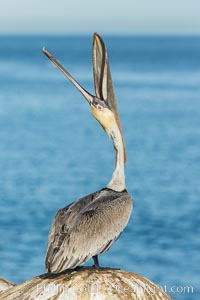
California Brown Pelican head throw, stretching its throat to keep it flexible and healthy. Note the winter mating plumage, olive and red throat, yellow head.
Species: Brown pelican, Pelecanus occidentalis, Pelecanus occidentalis californicus
Location: La Jolla, California
Image ID: 30328
Species: Brown pelican, Pelecanus occidentalis, Pelecanus occidentalis californicus
Location: La Jolla, California
Image ID: 30328
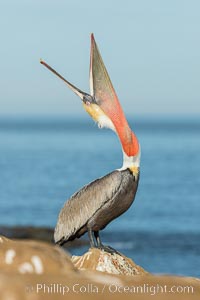
California Brown Pelican head throw, stretching its throat to keep it flexible and healthy. Note the winter mating plumage, olive and red throat, yellow head.
Species: Brown Pelican, Pelecanus occidentalis, Pelecanus occidentalis californicus
Location: La Jolla, California
Image ID: 30333
Species: Brown Pelican, Pelecanus occidentalis, Pelecanus occidentalis californicus
Location: La Jolla, California
Image ID: 30333
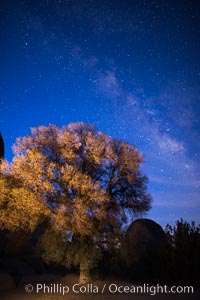
Live Oak and Milky Way, rocks and stars, Joshua Tree National Park at night.
Location: Joshua Tree National Park, California
Image ID: 28424
Location: Joshua Tree National Park, California
Image ID: 28424
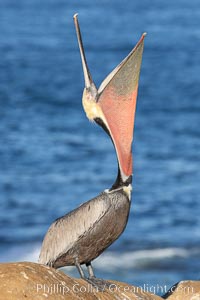
California Brown Pelican head throw, stretching its throat to keep it flexible and healthy. Note the winter mating plumage, olive and red throat, yellow head.
Species: Brown Pelican, Pelecanus occidentalis, Pelecanus occidentalis californicus
Location: La Jolla, California
Image ID: 37609
Species: Brown Pelican, Pelecanus occidentalis, Pelecanus occidentalis californicus
Location: La Jolla, California
Image ID: 37609
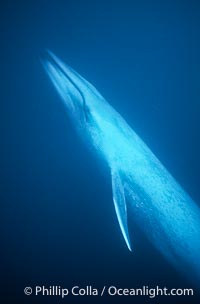
Blue whale, the large animal ever to live on earth, underwater view in the open ocean.
Species: Blue whale, Balaenoptera musculus
Image ID: 05814
Species: Blue whale, Balaenoptera musculus
Image ID: 05814
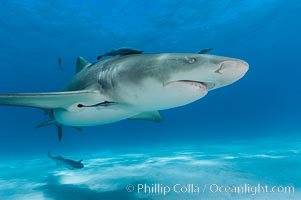
Lemon shark with live sharksuckers.
Species: Lemon shark, Echeneis naucrates, Negaprion brevirostris
Location: Bahamas
Image ID: 10754
Species: Lemon shark, Echeneis naucrates, Negaprion brevirostris
Location: Bahamas
Image ID: 10754
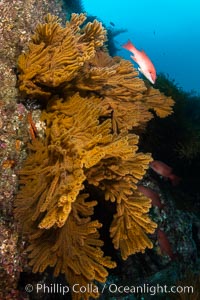
Golden gorgonian on underwater rocky reef, amid kelp forest, Catalina Island. The golden gorgonian is a filter-feeding temperate colonial species that lives on the rocky bottom at depths between 50 to 200 feet deep. Each individual polyp is a distinct animal, together they secrete calcium that forms the structure of the colony. Gorgonians are oriented at right angles to prevailing water currents to capture plankton drifting by.
Species: California golden gorgonian, Muricea californica
Location: Coronado Islands (Islas Coronado), Baja California, Mexico
Image ID: 35083
Species: California golden gorgonian, Muricea californica
Location: Coronado Islands (Islas Coronado), Baja California, Mexico
Image ID: 35083
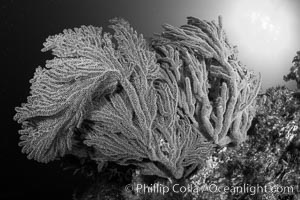
Golden gorgonian on underwater rocky reef, amid kelp forest, Catalina Island. The golden gorgonian is a filter-feeding temperate colonial species that lives on the rocky bottom at depths between 50 to 200 feet deep. Each individual polyp is a distinct animal, together they secrete calcium that forms the structure of the colony. Gorgonians are oriented at right angles to prevailing water currents to capture plankton drifting by.
Species: California golden gorgonian, Muricea californica
Location: Coronado Islands (Islas Coronado), Baja California, Mexico
Image ID: 35095
Species: California golden gorgonian, Muricea californica
Location: Coronado Islands (Islas Coronado), Baja California, Mexico
Image ID: 35095
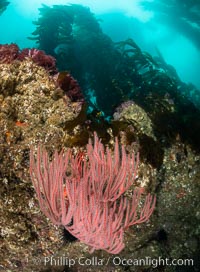
Red gorgonian on rocky reef, below kelp forest, underwater. The red gorgonian is a filter-feeding temperate colonial species that lives on the rocky bottom at depths between 50 to 200 feet deep. Gorgonians are oriented at right angles to prevailing water currents to capture plankton drifting by.
Species: Red gorgonian, Leptogorgia chilensis, Lophogorgia chilensis
Location: San Clemente Island, California
Image ID: 37055
Species: Red gorgonian, Leptogorgia chilensis, Lophogorgia chilensis
Location: San Clemente Island, California
Image ID: 37055
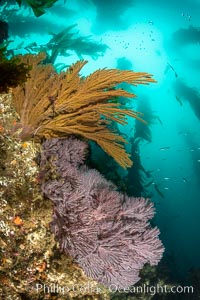
Brown gorgonian and California golden gorgonian on underwater rocky reef below kelp forest, San Clemente Island. Gorgonians are filter-feeding temperate colonial species that lives on the rocky bottom at depths between 50 to 200 feet deep. Each individual polyp is a distinct animal, together they secrete calcium that forms the structure of the colony. Gorgonians are oriented at right angles to prevailing water currents to capture plankton drifting by.
Species: Brown gorgonian, California golden gorgonian, Muricea californica, Muricea fruticosa
Location: San Clemente Island, California
Image ID: 37056
Species: Brown gorgonian, California golden gorgonian, Muricea californica, Muricea fruticosa
Location: San Clemente Island, California
Image ID: 37056
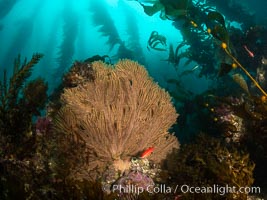
California golden gorgonian and small juvenile sheephead fishes on rocky reef, below kelp forest, underwater. The golden gorgonian is a filter-feeding temperate colonial species that lives on the rocky bottom at depths between 50 to 200 feet deep. Each individual polyp is a distinct animal, together they secrete calcium that forms the structure of the colony. Gorgonians are oriented at right angles to prevailing water currents to capture plankton drifting by.
Species: California golden gorgonian, Muricea californica
Location: San Clemente Island, California
Image ID: 37057
Species: California golden gorgonian, Muricea californica
Location: San Clemente Island, California
Image ID: 37057
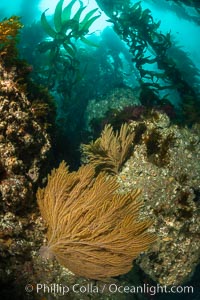
California golden gorgonian on underwater rocky reef below kelp forest, San Clemente Island. The golden gorgonian is a filter-feeding temperate colonial species that lives on the rocky bottom at depths between 50 to 200 feet deep. Each individual polyp is a distinct animal, together they secrete calcium that forms the structure of the colony. Gorgonians are oriented at right angles to prevailing water currents to capture plankton drifting by.
Species: California golden gorgonian, Muricea californica
Location: San Clemente Island, California
Image ID: 37058
Species: California golden gorgonian, Muricea californica
Location: San Clemente Island, California
Image ID: 37058
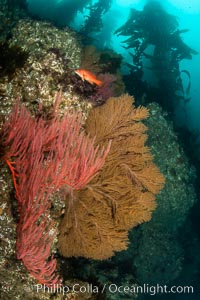
Red gorgonian and California golden gorgonian on underwater rocky reef below kelp forest, San Clemente Island. Gorgonians are filter-feeding temperate colonial species that lives on the rocky bottom at depths between 50 to 200 feet deep. Each individual polyp is a distinct animal, together they secrete calcium that forms the structure of the colony. Gorgonians are oriented at right angles to prevailing water currents to capture plankton drifting by, San Clemente Island. Gorgonians are oriented at right angles to prevailing water currents to capture plankton drifting by.
Species: Red gorgonian, Leptogorgia chilensis, Lophogorgia chilensis
Location: San Clemente Island, California
Image ID: 37060
Species: Red gorgonian, Leptogorgia chilensis, Lophogorgia chilensis
Location: San Clemente Island, California
Image ID: 37060
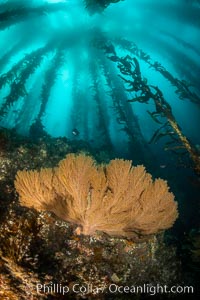
California golden gorgonian on underwater rocky reef below kelp forest, San Clemente Island. The golden gorgonian is a filter-feeding temperate colonial species that lives on the rocky bottom at depths between 50 to 200 feet deep. Each individual polyp is a distinct animal, together they secrete calcium that forms the structure of the colony. Gorgonians are oriented at right angles to prevailing water currents to capture plankton drifting by.
Species: California golden gorgonian, Muricea californica
Location: San Clemente Island, California
Image ID: 37098
Species: California golden gorgonian, Muricea californica
Location: San Clemente Island, California
Image ID: 37098
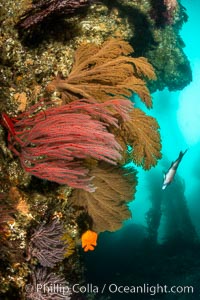
Red gorgonian and California golden gorgonian on underwater rocky reef below kelp forest, San Clemente Island. Gorgonians are filter-feeding temperate colonial species that lives on the rocky bottom at depths between 50 to 200 feet deep. Each individual polyp is a distinct animal, together they secrete calcium that forms the structure of the colony. Gorgonians are oriented at right angles to prevailing water currents to capture plankton drifting by, San Clemente Island. Gorgonians are oriented at right angles to prevailing water currents to capture plankton drifting by.
Species: Red gorgonian, Leptogorgia chilensis, Lophogorgia chilensis
Location: San Clemente Island, California
Image ID: 37115
Species: Red gorgonian, Leptogorgia chilensis, Lophogorgia chilensis
Location: San Clemente Island, California
Image ID: 37115
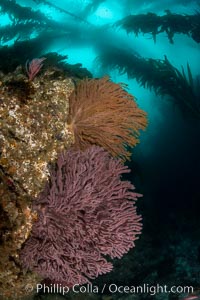
Brown gorgonian and California golden gorgonian on underwater rocky reef below kelp forest, San Clemente Island. Gorgonians are filter-feeding temperate colonial species that lives on the rocky bottom at depths between 50 to 200 feet deep. Each individual polyp is a distinct animal, together they secrete calcium that forms the structure of the colony. Gorgonians are oriented at right angles to prevailing water currents to capture plankton drifting by.
Species: Brown gorgonian, California golden gorgonian, Muricea californica, Muricea fruticosa
Location: San Clemente Island, California
Image ID: 37117
Species: Brown gorgonian, California golden gorgonian, Muricea californica, Muricea fruticosa
Location: San Clemente Island, California
Image ID: 37117
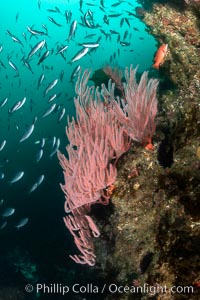
Red gorgonian on rocky reef, below kelp forest, underwater. The red gorgonian is a filter-feeding temperate colonial species that lives on the rocky bottom at depths between 50 to 200 feet deep. Gorgonians are oriented at right angles to prevailing water currents to capture plankton drifting by.
Species: Red gorgonian, Leptogorgia chilensis, Lophogorgia chilensis
Location: San Clemente Island, California
Image ID: 37120
Species: Red gorgonian, Leptogorgia chilensis, Lophogorgia chilensis
Location: San Clemente Island, California
Image ID: 37120
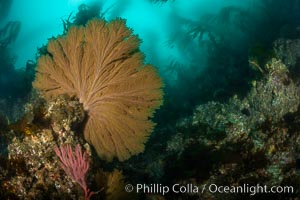
California golden gorgonian on underwater rocky reef below kelp forest, San Clemente Island. The golden gorgonian is a filter-feeding temperate colonial species that lives on the rocky bottom at depths between 50 to 200 feet deep. Each individual polyp is a distinct animal, together they secrete calcium that forms the structure of the colony. Gorgonians are oriented at right angles to prevailing water currents to capture plankton drifting by.
Species: California golden gorgonian, Muricea californica
Location: San Clemente Island, California
Image ID: 37123
Species: California golden gorgonian, Muricea californica
Location: San Clemente Island, California
Image ID: 37123
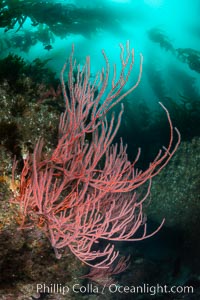
Red gorgonian on rocky reef, below kelp forest, underwater. The red gorgonian is a filter-feeding temperate colonial species that lives on the rocky bottom at depths between 50 to 200 feet deep. Gorgonians are oriented at right angles to prevailing water currents to capture plankton drifting by.
Species: Red gorgonian, Leptogorgia chilensis, Lophogorgia chilensis
Location: San Clemente Island, California
Image ID: 37124
Species: Red gorgonian, Leptogorgia chilensis, Lophogorgia chilensis
Location: San Clemente Island, California
Image ID: 37124
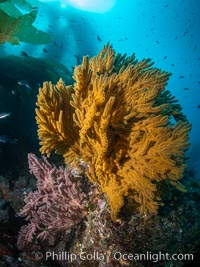
Golden gorgonian on underwater rocky reef, amid kelp forest, Catalina Island. The golden gorgonian is a filter-feeding temperate colonial species that lives on the rocky bottom at depths between 50 to 200 feet deep. Each individual polyp is a distinct animal, together they secrete calcium that forms the structure of the colony. Gorgonians are oriented at right angles to prevailing water currents to capture plankton drifting by.
Location: Catalina Island, California
Image ID: 37156
Location: Catalina Island, California
Image ID: 37156
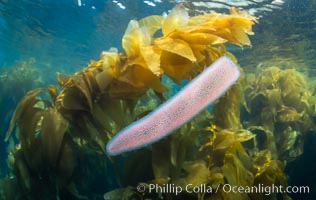
Pyrosome drifting through a kelp forest, Catalina Island. Pyrosomes are free-floating colonial tunicates that usually live in the upper layers of the open ocean in warm seas. Pyrosomes are cylindrical or cone-shaped colonies made up of hundreds to thousands of individuals, known as zooids.
Location: Catalina Island, California
Image ID: 37164
Location: Catalina Island, California
Image ID: 37164
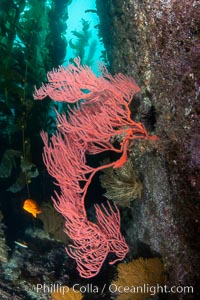
Red gorgonian on rocky reef, below kelp forest, underwater. The red gorgonian is a filter-feeding temperate colonial species that lives on the rocky bottom at depths between 50 to 200 feet deep. Gorgonians are oriented at right angles to prevailing water currents to capture plankton drifting by..
Species: Red gorgonian, Leptogorgia chilensis, Lophogorgia chilensis
Location: Catalina Island, California
Image ID: 37276
Species: Red gorgonian, Leptogorgia chilensis, Lophogorgia chilensis
Location: Catalina Island, California
Image ID: 37276
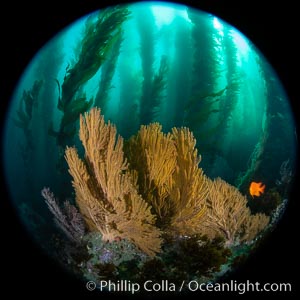
Golden gorgonian on underwater rocky reef, amid kelp forest, Catalina Island. The golden gorgonian is a filter-feeding temperate colonial species that lives on the rocky bottom at depths between 50 to 200 feet deep. Each individual polyp is a distinct animal, together they secrete calcium that forms the structure of the colony. Gorgonians are oriented at right angles to prevailing water currents to capture plankton drifting by.
Species: Giant kelp, California golden gorgonian, Macrocystis pyrifera, Muricea californica
Location: Catalina Island, California
Image ID: 37298
Species: Giant kelp, California golden gorgonian, Macrocystis pyrifera, Muricea californica
Location: Catalina Island, California
Image ID: 37298
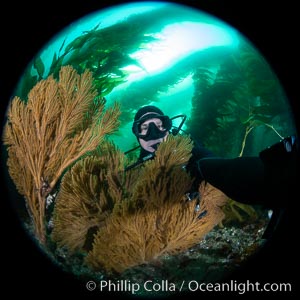
Golden gorgonian on underwater rocky reef, amid kelp forest, Catalina Island. The golden gorgonian is a filter-feeding temperate colonial species that lives on the rocky bottom at depths between 50 to 200 feet deep. Each individual polyp is a distinct animal, together they secrete calcium that forms the structure of the colony. Gorgonians are oriented at right angles to prevailing water currents to capture plankton drifting by.
Species: Giant kelp, California golden gorgonian, Macrocystis pyrifera, Muricea californica
Location: Catalina Island, California
Image ID: 37299
Species: Giant kelp, California golden gorgonian, Macrocystis pyrifera, Muricea californica
Location: Catalina Island, California
Image ID: 37299